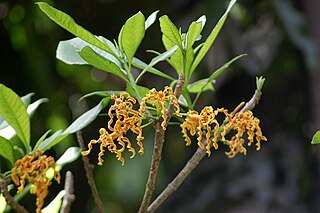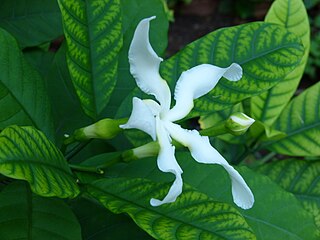
Strophanthus sarmentosus grows as either a deciduous shrub or as a liana up to 40 metres (130 ft) long, with a stem diameter up to 15 centimetres (6 in). Its fragrant flowers feature a white to purple corolla, red or purple-streaked on the inside. Strophanthus sarmentosus is native from west and central tropical Africa to Uganda and Angola. Vernacular names for the plant include spider tresses and poison arrow vine. Its habitat is forested areas from sea level to 1,400 metres (4,600 ft) altitude.
Strophanthus welwitschii grows as a deciduous shrub or small tree up to 5 metres (16 ft) tall, or as a liana up to 8 metres (26 ft) long, with a stem diameter up to 10 centimetres (4 in). Its fragrant flowers feature a white turning purple corolla, creamy and red or purple-streaked on the inside. Its habitat is forests or rocky woodlands from 300 metres (1,000 ft) to 1,800 metres (6,000 ft) altitude. S. welwitschii is used in local medicinal treatments for respiratory conditions, gonorrhoea and scabies. The plant has been used as arrow poison. Strophanthus welwitschii is native to Democratic Republic of Congo, Tanzania, Angola and Zambia.

Strophanthus boivinii, the wood shaving flower, is a species of plant in the family Apocynaceae.
Strophanthus courmontii grows as a deciduous liana up to 22 metres (72 ft) long or as a shrub up to 4 metres (13 ft) tall, with a stem diameter up to 10 centimetres (3.9 in). Its fragrant flowers feature a white turning red and purple corolla tube, yellow with purple streaks inside. Habitats are forests and riverine thickets, from sea level to 1,400 metres (4,600 ft) altitude. S. courmontii is used in local medicinal treatments for rheumatism and as an aphrodisiac. The plant is native to Kenya, Tanzania, Malawi, Mozambique, Zambia and Zimbabwe.

Strophanthus eminii is a species of flowering plant in the Apocynaceae family. It is referred to by the common name Emin's strophanthus, and grows as a liana up to 10 metres (33 ft) long or as a shrub or small tree up to 7 metres (23 ft) tall, with a stem diameter up to 6 centimetres (2.4 in). Its fragrant flowers feature a pink with white turning red corolla tube, white turning yellow with red spots and streaks inside. Vernacular names for the plant include "spider tresses" and "poison arrow vine". Its habitat is deciduous woodland or rocky bushland, from 600 metres (2,000 ft) to 1,650 metres (5,400 ft) altitude. Strophanthus eminii is used in local medicinal treatments for snakebites, skin diseases and wounds and also as an anthelmintic. The plant has been used as arrow poison. It is native to Democratic Republic of Congo, Tanzania and Zambia.
Hunteria congolana grows as either a shrub or a tree up to 20 metres (66 ft) tall, with a trunk diameter of up to 30 centimetres (12 in). Its flowers feature a white or yellow corolla, turning pink when in bud. Fruit is yellow to bright orange. Habitat is primary forest from 500 metres (1,600 ft) to 1,700 metres (5,600 ft) altitude. Local medicinal uses include for fever, diarrhoea and as an anthelmintic. H. congolana has been used as arrow poison. The plant is native to Democratic Republic of Congo and Kenya.
Hunteria umbellata grows as either a shrub or small tree up to 22 metres (72 ft) tall, with a trunk diameter of up to 40 centimetres (16 in). Its flowers feature a white, creamy or pale yellow corolla. The fruit is yellow and smooth. Its habitat is forests from sea level to 600 metres (2,000 ft) altitude. Its numerous local medicinal uses include for fever, leprosy sores, stomach and liver problems and as an anthelmintic, especially against internal worms. Hunteria umbellata has been used as arrow poison. The plant's hard wood is used in carving and to make small tools. The species is native to an area of tropical Africa from Guinea-Bissau in the west to Angola in the south.
Hunteria zeylanica grows as either an evergreen shrub or as a tree up to 15 metres (49 ft) tall, with a trunk diameter of up to 34.5 centimetres (13.6 in). Its flowers feature a white corolla. The berries are yellow. Its habitat is forests from sea level to 350 metres (1,150 ft) altitude. The trees can withstand salinity. Local medicinal uses include for stomach-ache. Hunteria zeylanica wood is used for weapon handles and as firewood. In Africa, the plant is native to Kenya and Tanzania and in Asia it is native to China, India, Sri Lanka, Indochina and western Malesia.

Ochrosia oppositifolia grows as a small to medium-sized tree up to 25 metres (82 ft) tall, with a trunk diameter of up to 50 centimetres (20 in). Its flowers feature a creamy to white corolla. Its habitat is coastal forest, bush or open areas to 100 metres (330 ft) altitude, rarely inland. Local medicinal uses include as a carminative and in high doses as an abortifacient. Ochrosia oppositifolia is native to regions from the Seychelles through tropical Asia to the Pacific.
Pleioceras barteri grows as a shrub, liana or small tree up to 4 metres (13 ft) tall. Its flowers feature dark red or violet corolla lobes with yellow apex. Its habitat is forests, bush or open ground in coastal areas from sea level to 500 metres (1,600 ft) altitude. Local traditional medicinal uses include as an emmenagogue, abortifacient and also in the treatment of rheumatism and malaria. Pleioceras barteri is native to tropical West Africa and Cameroon.
Tabernaemontana coffeoides is a species of flowering plant in the Apocynaceae family. It grows as a shrub or small tree up to 10 metres (33 ft) tall, with a trunk diameter of up to 20 centimetres (8 in). Its fragrant flowers feature white corolla lobes. Its habitat is on dunes or on rocks in dry forest, bush or savanna from sea level to 1,300 metres (4,300 ft) altitude. Local medicinal uses include for weight loss and to combat fatigue. Tabernaemontana coffeoides is native to Seychelles, the Comoros and Madagascar. It is also rich in pharmacologically interesting indole alkaloids.

Tabernaemontana pachysiphon grows as a shrub or small tree up to 15 metres (50 ft) tall, with a trunk diameter of up to 40 centimetres (16 in). Its fragrant flowers feature white to pale yellow corolla lobes. The fruit is green, almost spherical, up to 15 centimetres (6 in) in diameter. Its habitat is forests from sea level to 2,200 metres (7,200 ft) altitude. Its numerous local medicinal uses include as a styptic, and as a treatment for headache, hypertension and to relieve cramps. The species is native to tropical Africa.

Tabernaemontana ventricosa is a plant in the family Apocynaceae. It grows as a shrub or small tree up to 15 metres (50 ft) tall, with a trunk diameter of up to 30 centimetres (12 in) and has white sap. Leaves are paired and crowded near the ends of branches. They are oblong, leathery and a glossy dark green. Flowers are fragrant with white, somewhat twisted lobes, often with a pale yellow center and are set in small clusters at the ends of branches. The fruit is dark green, set in spreading pairs of ellipsoids or oval, beaked pods, up to 10 centimetres (4 in) in diameter. Its habitat is forests from sea level to 1,850 metres (6,000 ft) altitude. In Zimbabwe, it is usually found as part of the understorey of evergreen forests. Local medicinal uses include the treatment of wounds, fever and hypertension. The plant is native to tropical central and southern Africa.
Wrightia demartiniana is a plant in the dogbane family Apocynaceae.
Alafia landolphioides grows as a liana up to 20 metres (66 ft) long, with a stem diameter of up to 2.5 centimetres (1 in). Its fragrant flowers feature a white corolla, dark red at the throat. The fruit is dark brown with paired cylindrical follicles, each up to 45 centimetres (18 in) in diameter.
Alafia lucida is a plant in the family Apocynaceae.
Alafia multiflora is a plant in the family Apocynaceae.

Callichilia barteri grows as a shrub up to 3 metres (9.8 ft) tall. Its fragrant flowers feature a white corolla. Fruit is yellow to orange with paired follicles, each up to 5 centimetres (2.0 in) long. Habitat is in forests. Local medicinal uses include as a treatment for gonorrhoea and as an anthelmintic and childhood laxative. C. barteri is found in Togo, Benin, Nigeria, Cameroon, the Republic of Congo and the Democratic Republic of Congo.
Oncinotis glabrata grows as a climbing shrub or liana up to 50 metres (160 ft) long, with a stem diameter of up to 12 centimetres (4.7 in). Its fragrant flowers feature a yellow to greenish yellow corolla. Fruit consists of paired follicles, each up to 30 centimetres (12 in) long. Habitat is forests from sea-level to 2,200 metres (7,200 ft) altitude. Local medicinal uses include as a treatment for yaws sores. O. glabrata is found in Guinea, Liberia, Ivory Coast, Ghana, Benin, Nigeria, Cameroon, the Central African Republic, Equatorial Guinea, Gabon, the Republic of Congo, the Democratic Republic of Congo, Burundi, Uganda, Tanzania and Angola.

Voacanga thouarsii, the wild frangipani, is a species of small tree in the family Apocynaceae.







